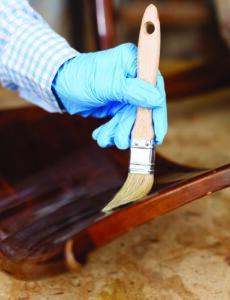Our valued treasures are sometimes damaged from wear and tear, age, moving and accidents.
There is also sunlight, wind, rain and dampness that can change or unsettle a piece.
Dust, mites and insects, storage and improper care are all factors to consider when an antique needs restoration, cleaning or repair.
There are many fields in the industry of antique restoration and repair.

Conservation, preservation, restoration, repair, stripping and refinishing are just a few fields where experts study and implement their crafts to save a piece of history.
People who work in the field of antique restoration are usually highly skilled, trained, and have completed apprentice training in their chosen profession, especially in Europe.
Skilled craftspeople like blacksmiths, engineers, automobile mechanics, furniture builders and art restoration experts all utilize their specialized skills in the restoration and repair industry.
People can also be self-taught, using their skills and interests for years in any chosen field, and working with a myriad of materials.
Materials are an important factor in restoration-versus-repairs.
Restorative practices utilize materials and customs only used during a certain time period.
If you have a table that was glued together in the 1800s, and needs to be reglued, and have leather on the top replaced, you would only be able to use, for example, glue used during that time period, and techniques and leather pieces that were only from and utilized in that time period for authenticity.
If you were just repairing an object, you might use modern glue and modern machinery for the task, whereas restoration might have you using antique wood tools by hand.
Antique restoration is to restore a piece back to its original appearance or character.
Those who work in this field can utilize their skills to remove grime and debris from items such as paintings and objects, or rebuilding and replacement of items missing or damaged off of a piece, like wood in furniture items or restoration of old ships, automobiles or machines.
The idea or goal behind restoration is to restore the original intention of the piece, and leave a very small footprint.
Many museums around the world utilize restoration processes for antiquity and works of art in all fields, especially paintings and broken objects of history and value.
Restoration experts all have their unique challenges.
Many patrons of antiques do not want original patina removed from a very old piece, as it takes away the history and original charm.
Bad repairs, or repairs done incorrectly also devalue a piece and sometimes destroy the original appearance, making it impossible to duplicate or salvage, whereas the term preservation is the attempt to slow down the deteriorating influences of time, and is also utilized by the serious collector.
Antique repair can take on many skill sets, but unlike restoration, usually involves making the antique functional again, and in working order.
It can also involve and be coupled with restoration practices, if the original structure is desired to be represented in the piece.
Examples of the marriage of restoration and repair would be paintings with damage, unique historical pieces of furniture that require the same wood type to be authentic, automobiles that need vintage parts, and furniture that utilizes special finishes.
There is a great need in the porcelain and pottery industry as well, to mend broken handles and cracks, dings, flea bites and shattering of unique or historical pieces.
French polish, a hand-rubbing technique that was used before machinery sprayed on the finish on furniture, is a lost art and it is hard to find practitioners who can now complete this complicated craft.
Many of the old ways are dying off with the older traditions, and there is a need in the antiques and antiquities industry for skills that are being forgotten or no longer taught or used in apprentice programs.
Special glues, formulas, old ingredients that are hard to find and the skills to use old tools are all problems and hurdles for the company or individual that wishes to pursue restoration and repair in the old fashions.
Many objects are multi-faceted, and might require work on blacksmith metal elements, fabric restoration, wood cleaning and damage.
An antiques restorer needs much knowledge and experience to tackle an entire, complicated process on some pieces, and this requires training, experience and the ability to wear many hats.
The restoration and repair field is vast.
Antique clothing, painting, weavings and rugs, needlepoint, tapestries, automobiles, boats, cars, airplanes, decorative objects, stained glass, regular glass, clocks, porcelain, pottery, furniture, and metal are just a few antique items that can be restored, repaired, cleaned, and cared for in many different ways that involve conservation, restoration, salvage and more.
The field is as vast as the world of antiques, and just as interesting.
At the end of the day, the goal is to save history, restore pride, learn a trade and take pride in one’s work.
Restoration and repair of antiques utilizes all of theses skills and more, and is a rewarding career or hobby.
(Editor’s note: DeeDee Wood is the owner of Black Cat Curiosities, an online antiques research and sales venue.)



